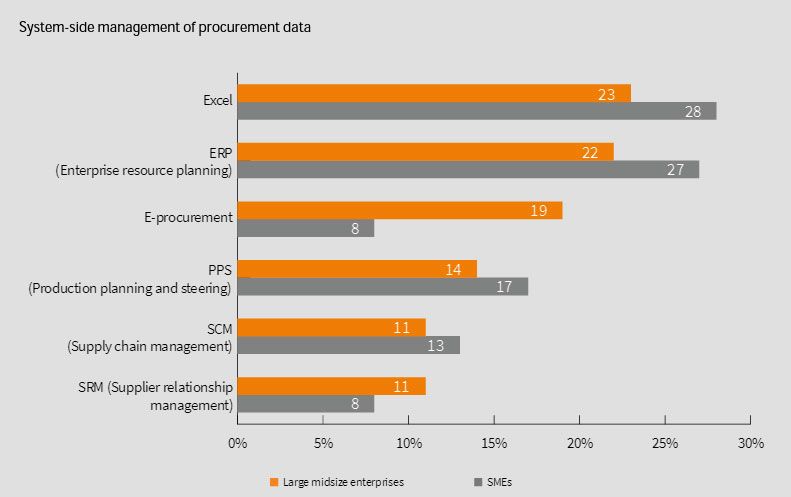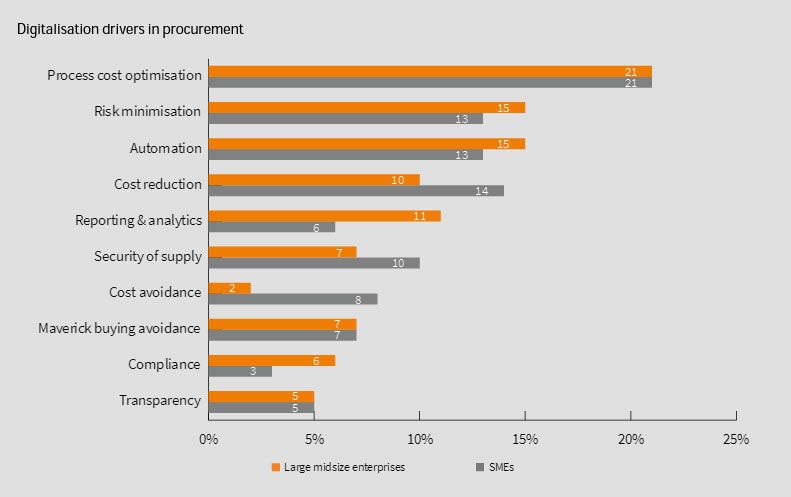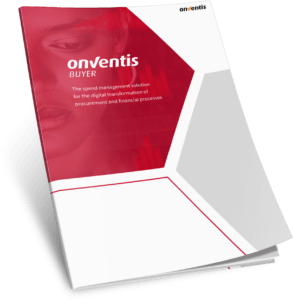Excel for Procurement: Why Excel Fails as a Purchasing Tool
As a critical function of an organization, procurement aims to cut costs and meet business needs efficiently. In the world of procurement, where accuracy and cost reduction are paramount, organizations often rely on digital tools to streamline their processes. One tool that is often used is Excel – very versatile, yet it does not meet the specific requirements and strategic goals of procurement organizations.

Excel for Procurement: Why Excel Fails as a Purchasing Tool
As a critical function of an organization, procurement aims to cut costs and meet business needs efficiently. In the world of procurement, where accuracy and cost reduction are the primary focus, organizations often rely on digital tools to streamline their processes.
In our annual study on the digital progress of procurement organizations, we examine the current state of procurement in midsize companies. In doing so, we asked these companies what systems they use to manage procurement data. Most respondents indicated that error-prone Excel is the leading system in their procurement activities, more frequently than ERP systems for the first-time year-on-year. A weak data foundation for digital purchasing processes!

Source: Procurement Barometer 2022. Sustainable Procurement and Supply Chains, Onventis GmbH in cooperation with BME, ESB Business School
Excel is undoubtedly a widely used tool in procurement, however, it often fails to meet the strategies and goals of procurement organizations. In this blog post, we will explore why Excel may not be the optimal solution for the purchasing process. The disadvantages of Excel will be highlighted, as well as the risks associated with its continued use. It will demonstrate what alternative solutions should be considered to ensure more efficient and effective procurement processes.
The Limits and Risks of Excel in Procurement
Proneness to errors and data inconsistencies
Manual data entry and formula editing in Excel make it prone to errors and data inconsistencies. Typos and incorrect formulas can lead to inaccurate results, affecting procurement operations. By the time errors are discovered, it may be too late to correct them. This negatively impacts buyers’ decision-making power and their ability to take informed action.
Growing complexity
As the complexity of procurement processes increases, the limits of Excel become clear. Managing multiple purchase orders from different suppliers and, therefore, large amounts of data is difficult and time-consuming. Excel lacks the ability to expand necessary to meet the increasing demands of a growing procurement organization. The more the company has to procure, the more difficult it becomes to manage the data mapped into Excel. The result is errors in the system and purchasing activities that go over buyers’ heads.
Slow and inefficient processes
The manual nature of Excel slows down procurement processes and impacts efficiency and productivity. Updating spreadsheets by hand, navigating multiple tabs, and reconciling data are time-consuming and labor-intensive tasks. Agility and collaboration within procurement teams are only possible if automation and workflow management capabilities are present within the tool. However, tools that increase the level of automation and thus simplify processes are crucial for effective procurement.
Security concerns
Excel files shared via email or stored locally pose security risks to internal procurement data. Confidential information such as pricing data and vendor contracts can be exposed to unauthorized access or loss because Excel’s limited security features do not protect sensitive data. It is advisable not to rely on Excel and to create more security using digital procurement tools.
Lack of collaboration functions
Collaboration and cooperation between stakeholders from different departments and suppliers are paramount in procurement. However, Excel offers only impaired communication functions and real-time updates. If collaboration could be more efficient, this would also affect procurement processes. Misunderstandings, missed opportunities, and increased risk of errors lead to delays in actions and, in the worst case, to wrong decisions.
Complex approval processes
Excel’s linear structure is unsuitable for managing complex approval processes. Tracking approval chains, monitoring progress, and maintaining supporting documentation get difficult and error prone. Excel’s limitations in managing complex approval workflows lead to inefficiencies and potential bottlenecks. Especially in procurement, it is important to establish and control these processes. If there is no system in place for this, the overview of necessary and placed orders is lost, gets out of control and leads to an inefficient and costly process. Increased transparency in purchasing through approval workflows ensures that procurement processes follow established procedures and approvals are obtained to track purchases and avoid maverick buying.
If Not Excel, Then What?
In our previously mentioned study, it is evident that many purchasers are driving digitization based on various trends. Cost optimization and reduction, risk minimization, and automation play the main roles. However, Excel is insufficient for these goals.

Source: Procurement Barometer 2022. Sustainable Procurement and Supply Chains, Onventis GmbH in cooperation with BME, ESB Business School
While Excel is a versatile tool, it does not meet the specific needs and strategic objectives of procurement organizations. Its error-proneness, inability to handle growing complexity, slow processes, and other challenges hinder procurement success. To overcome these limitations, procurement professionals should consider implementing dedicated procurement management tools that provide automation and security. Using advanced digital tools, buyers can increase efficiency, accuracy, and strategic value to succeed in the dynamic business world.
Source-to-pay systems are the solution to the challenges that Excel cannot solve. S2P represents the strategic end-to-end procurement process through which all phases of purchasing can be handled digitally. Procurement activities can thus be managed holistically and comprehensively without relying on failure-prone Excel. Particularly in purchasing, digitization, and automation offer enormous added value to take the pressure off it and simplify the entire process. This eliminates the need for complicated formulas and endless spreadsheets, while procurement activities can be handled smoothly and quickly!
When will you plunge into the efficient world of source-to-pay and benefit from the many advantages offered by a holistic procurement solution? If you don’t yet know the possibilities S2P brings you, read our blog on the subject. Follow us on LinkedIn or subscribe to our newsletter to stay informed about the latest procurement topics!
Weitere BlogsMore BlogsMeer blogs





